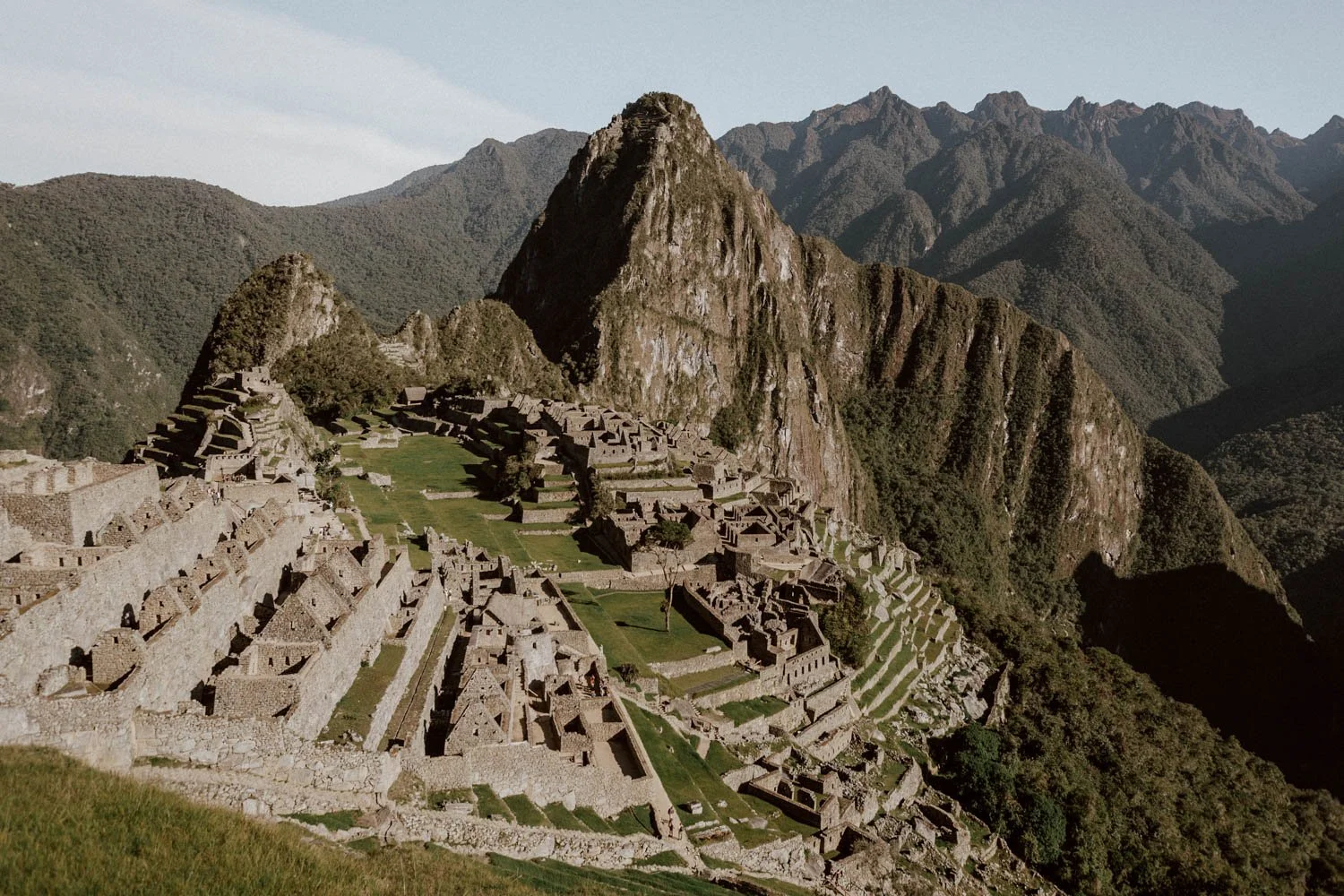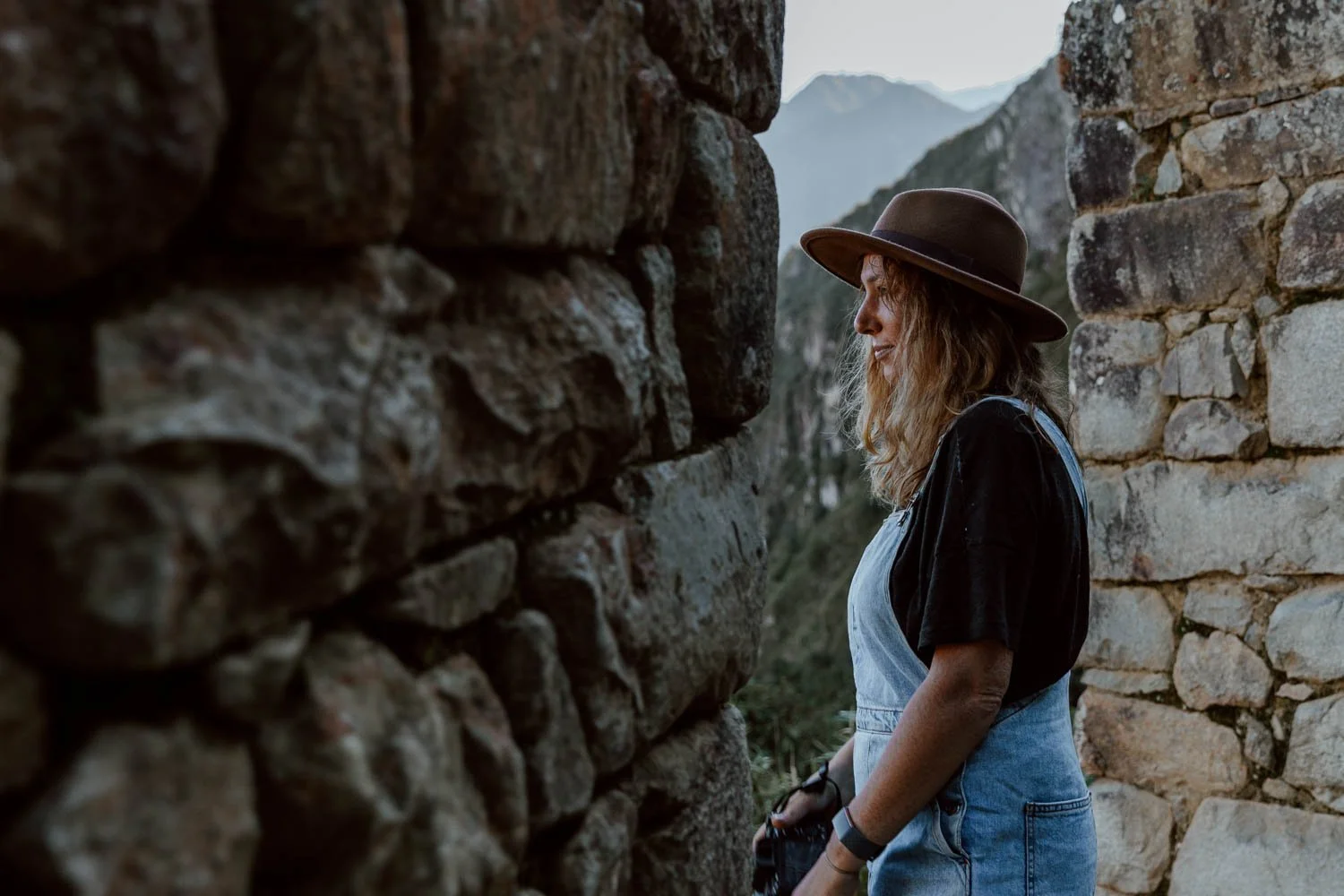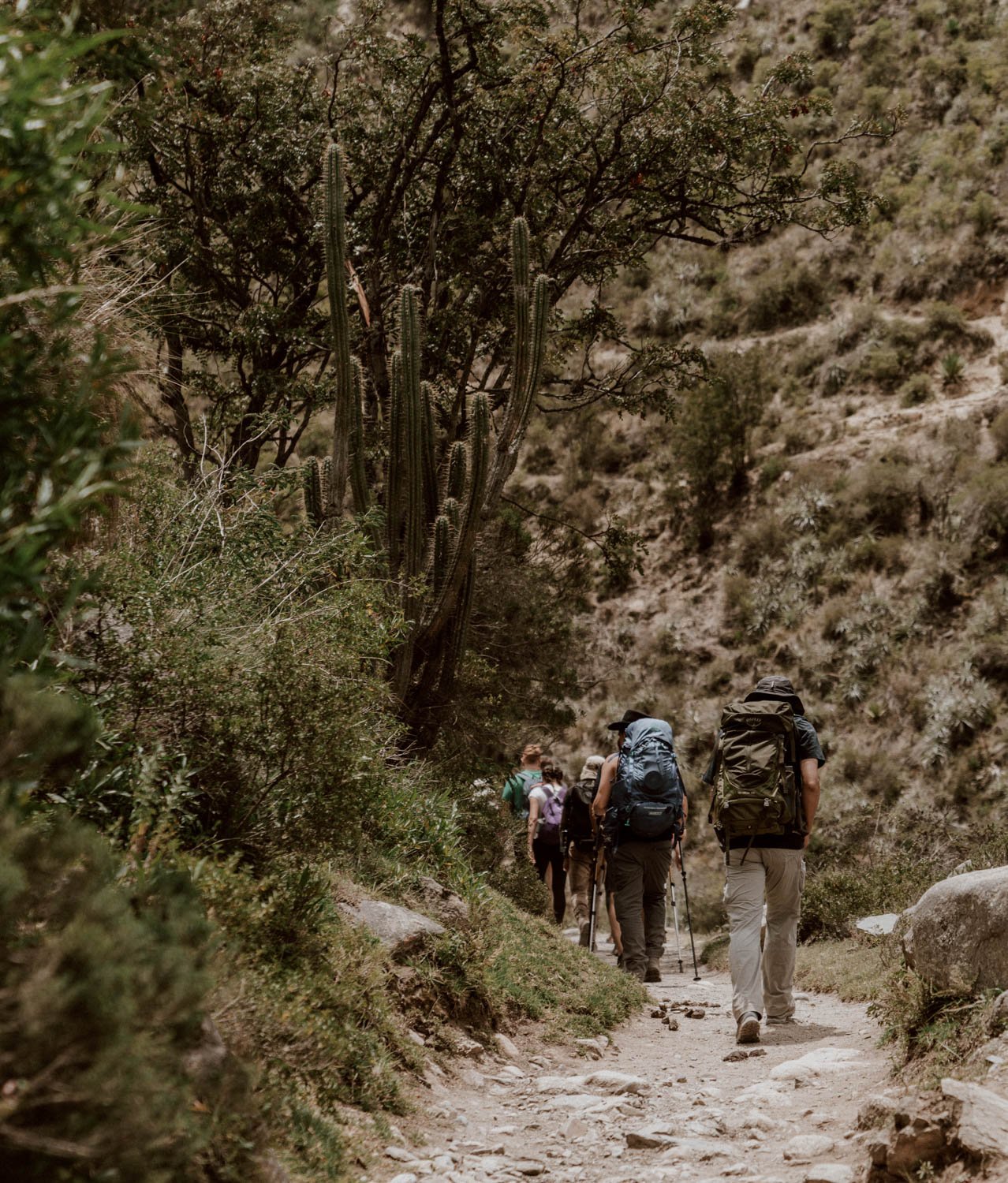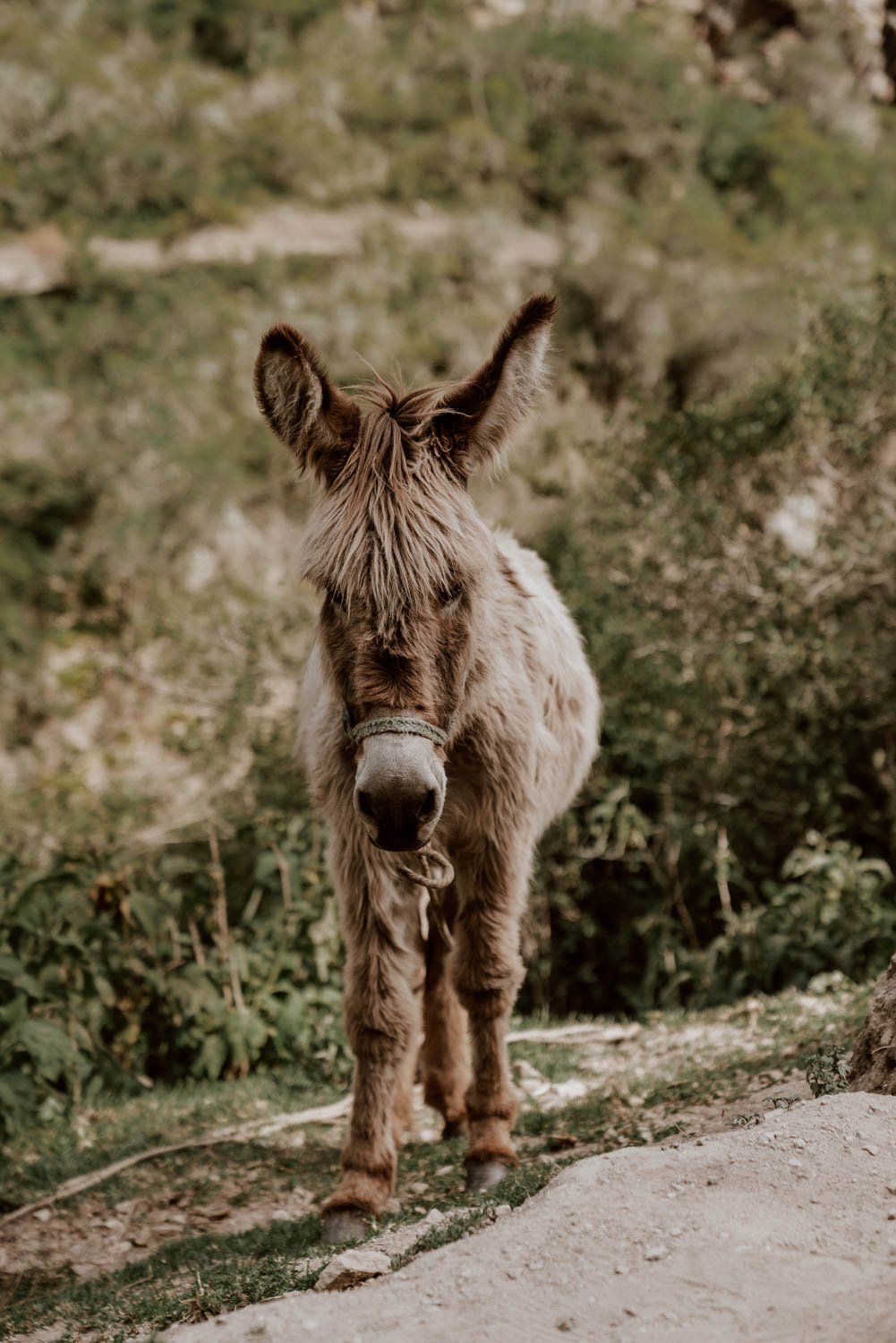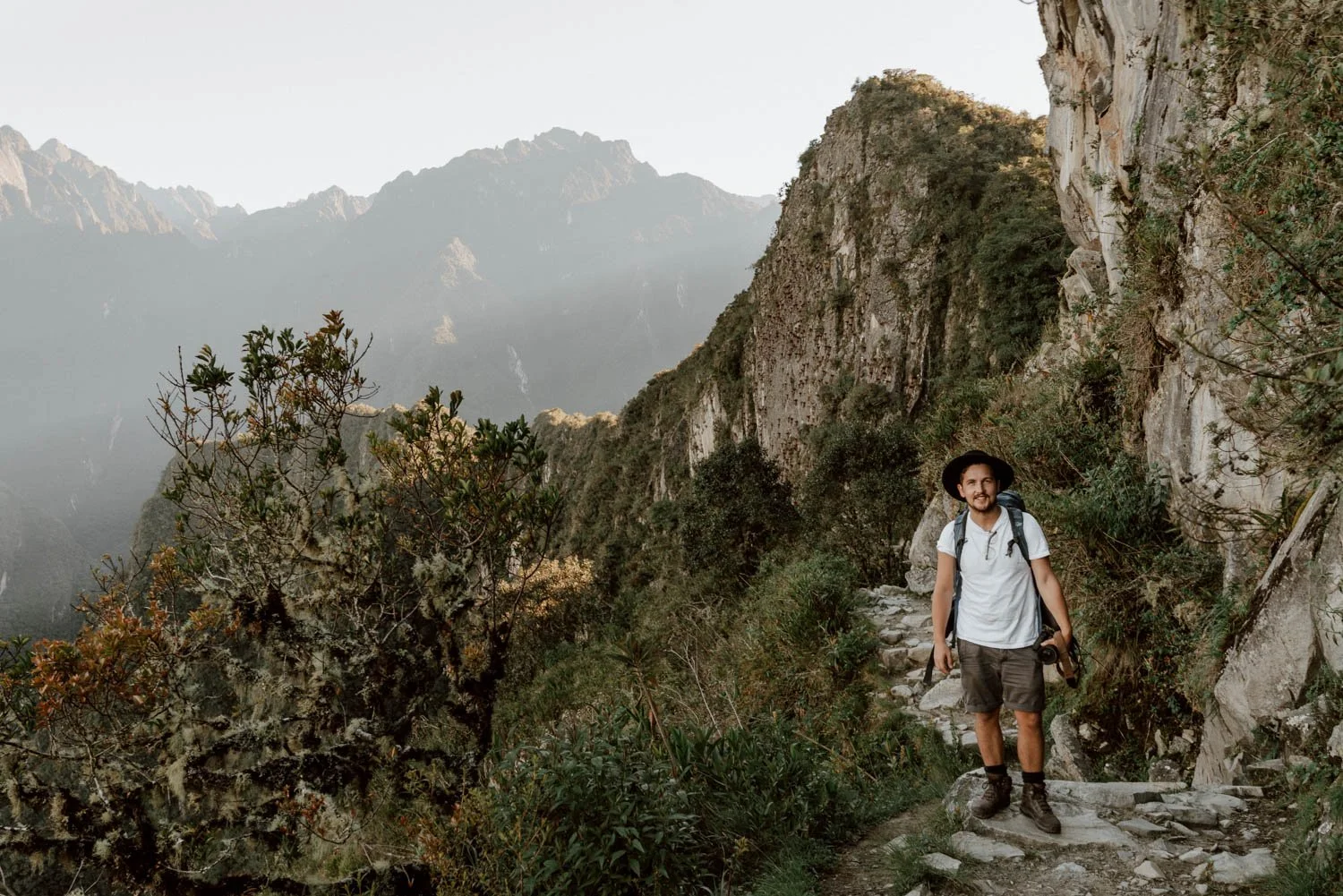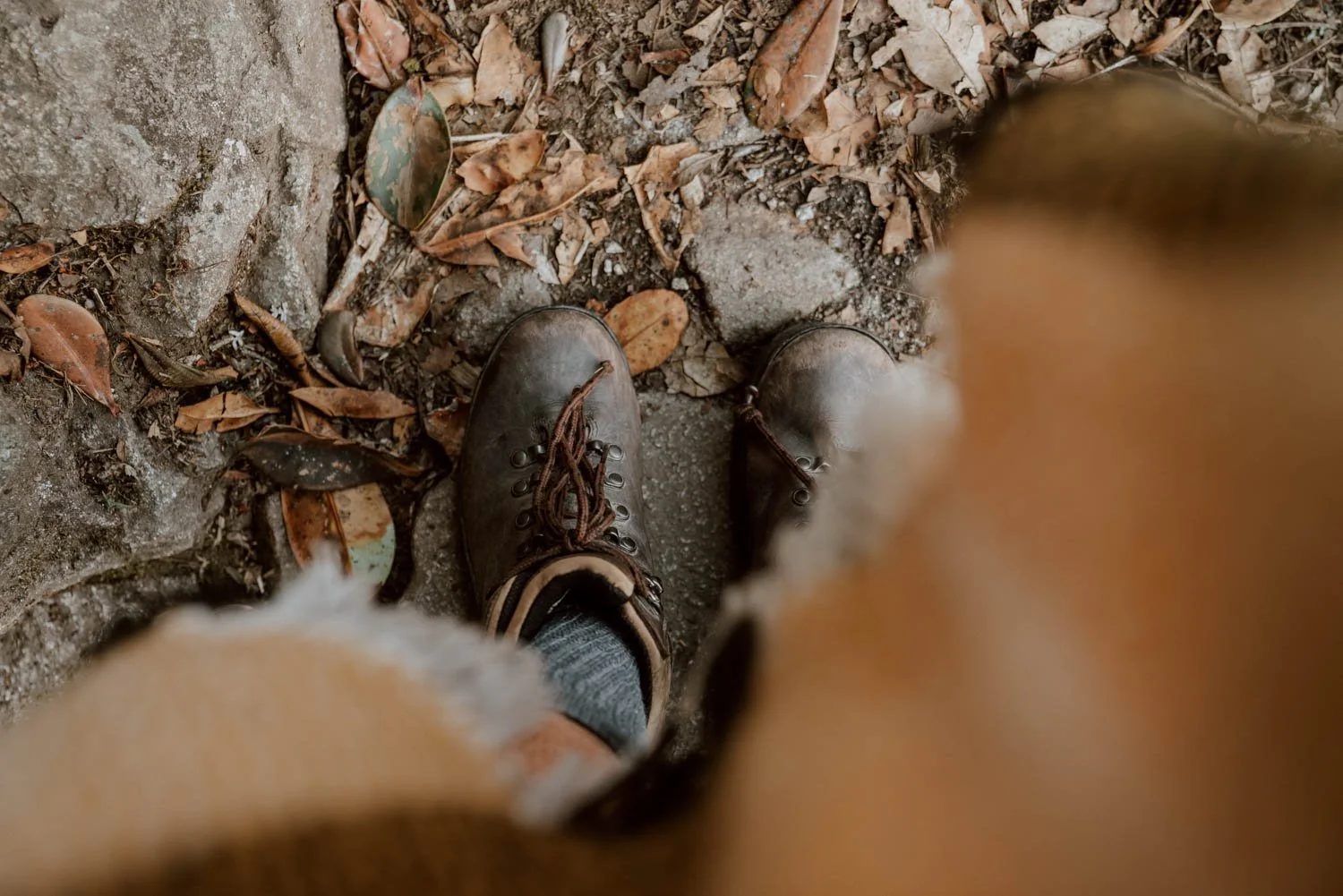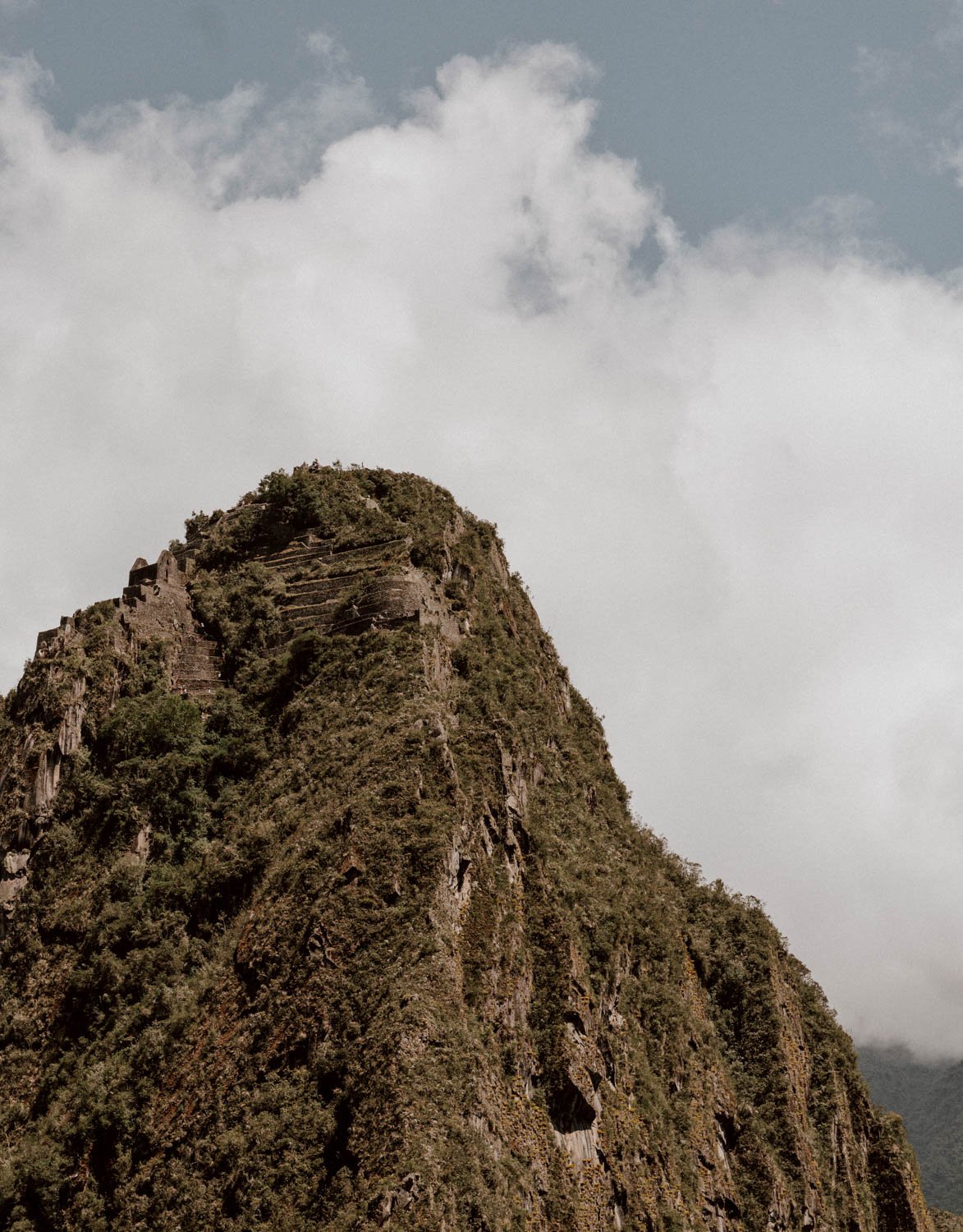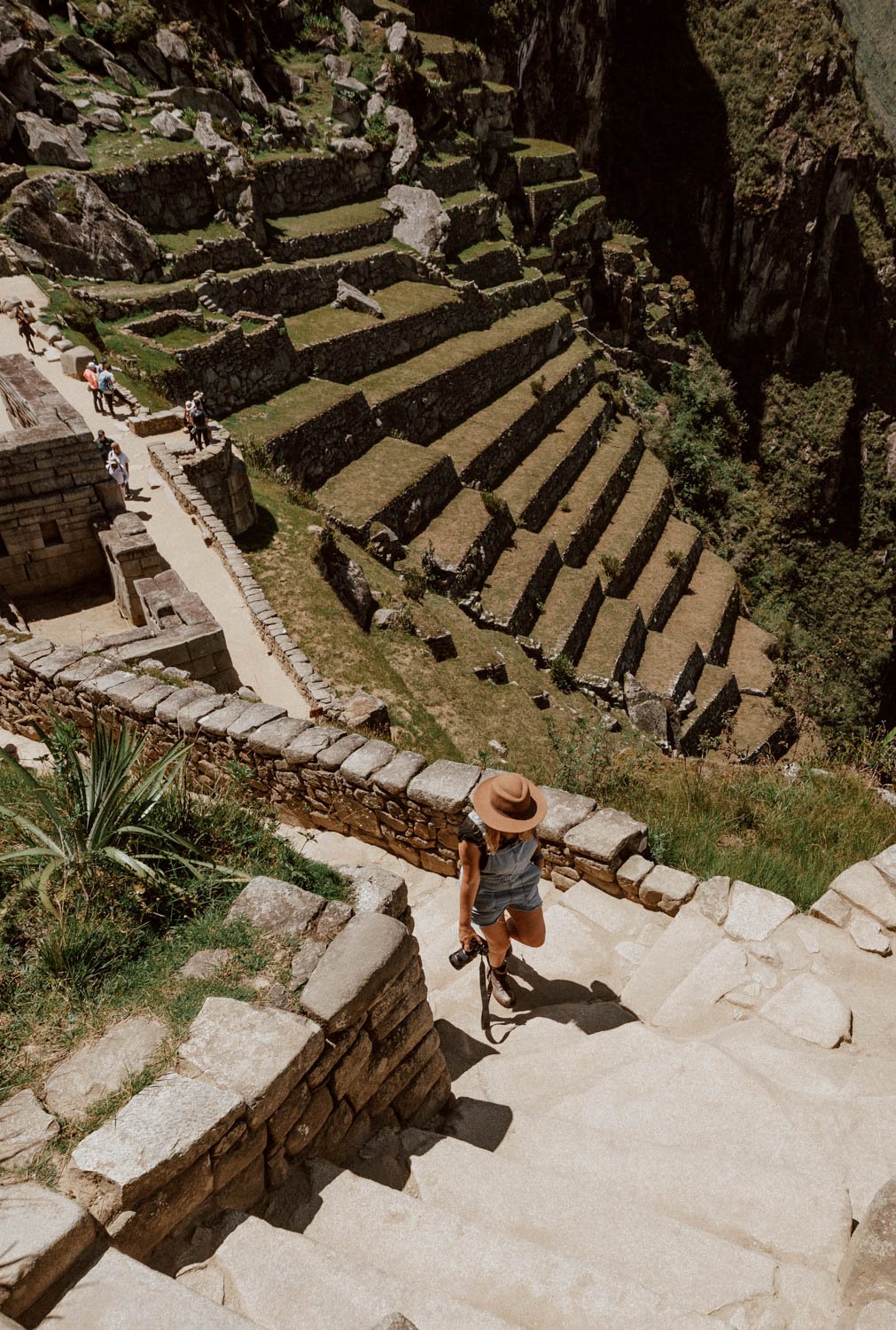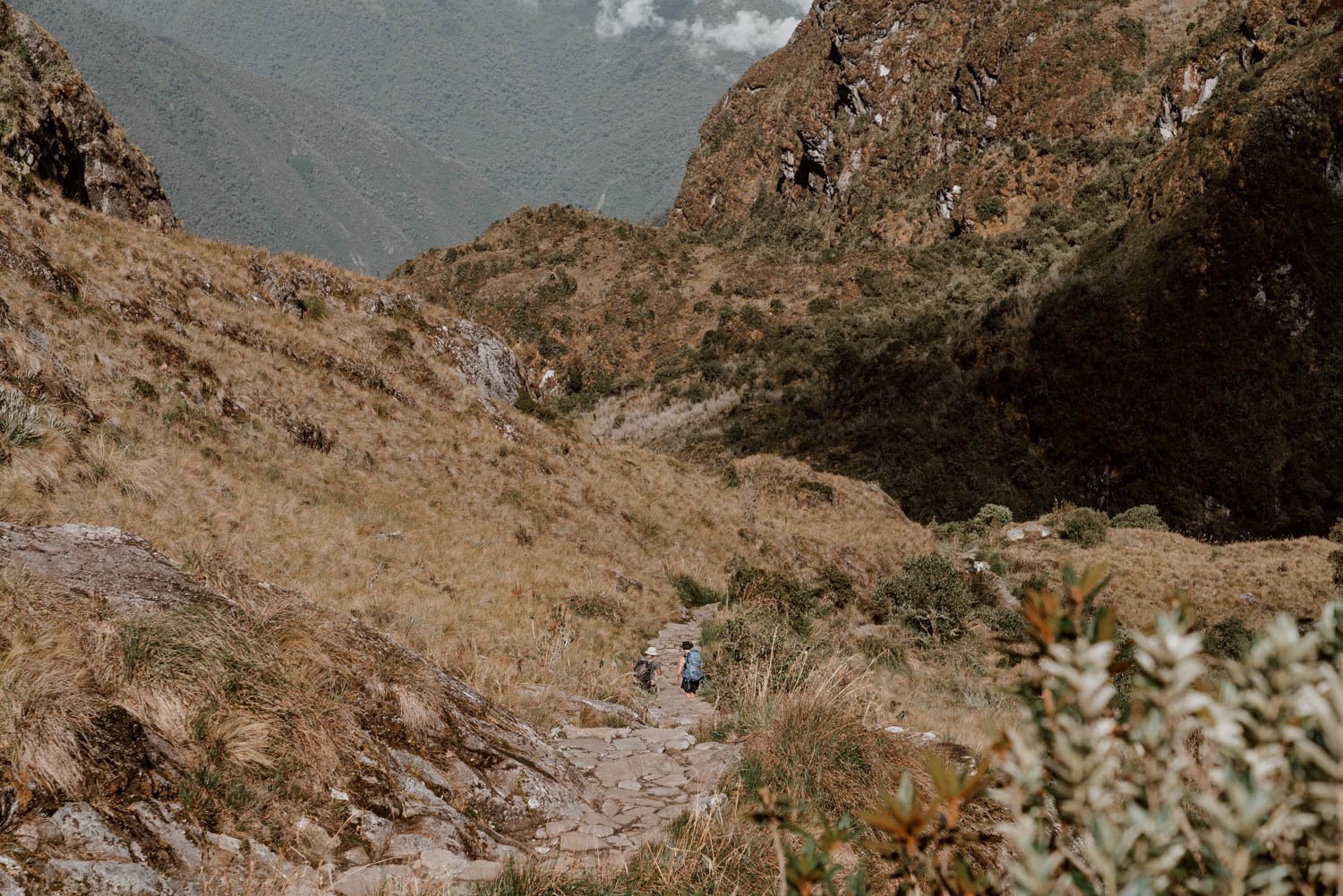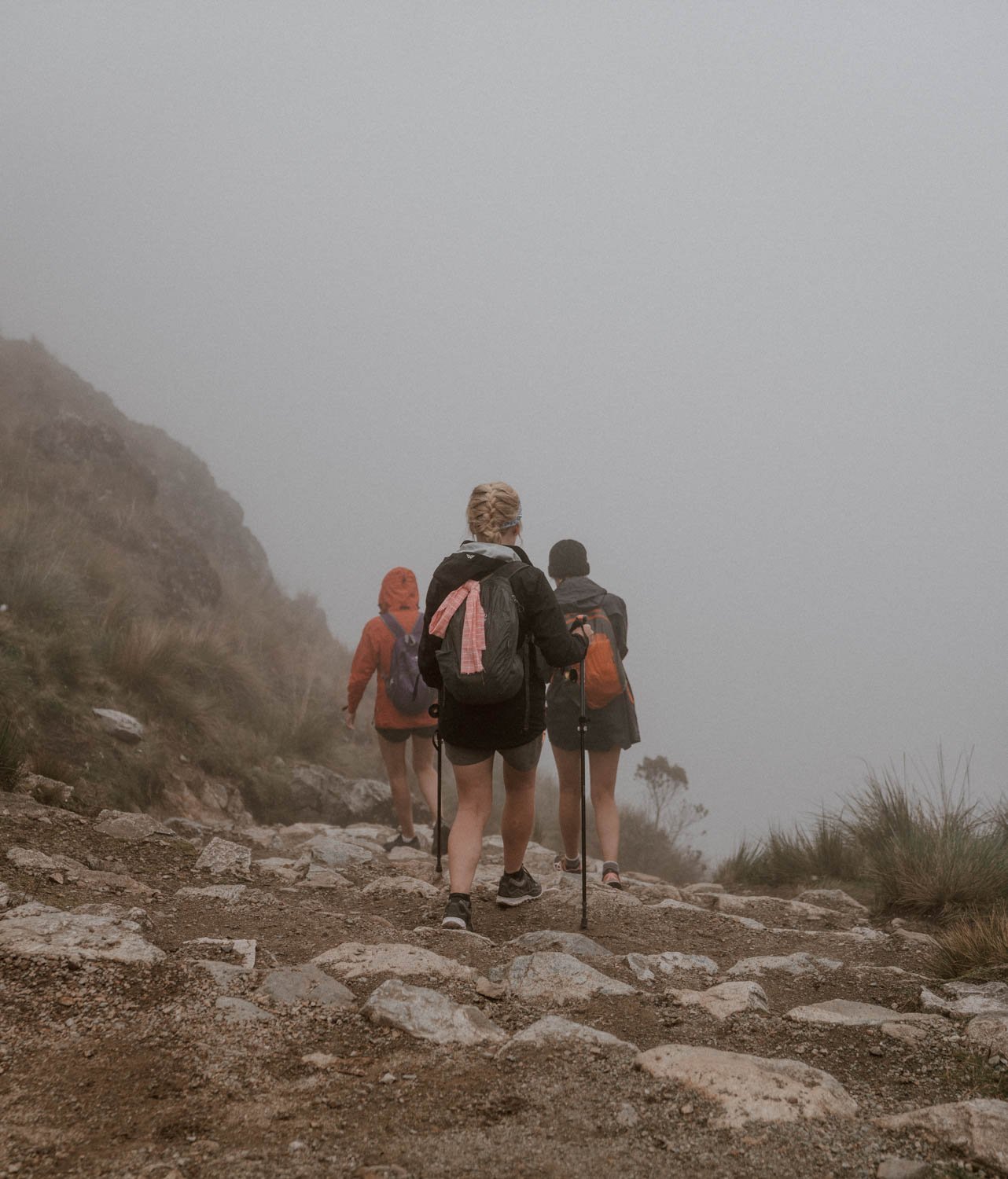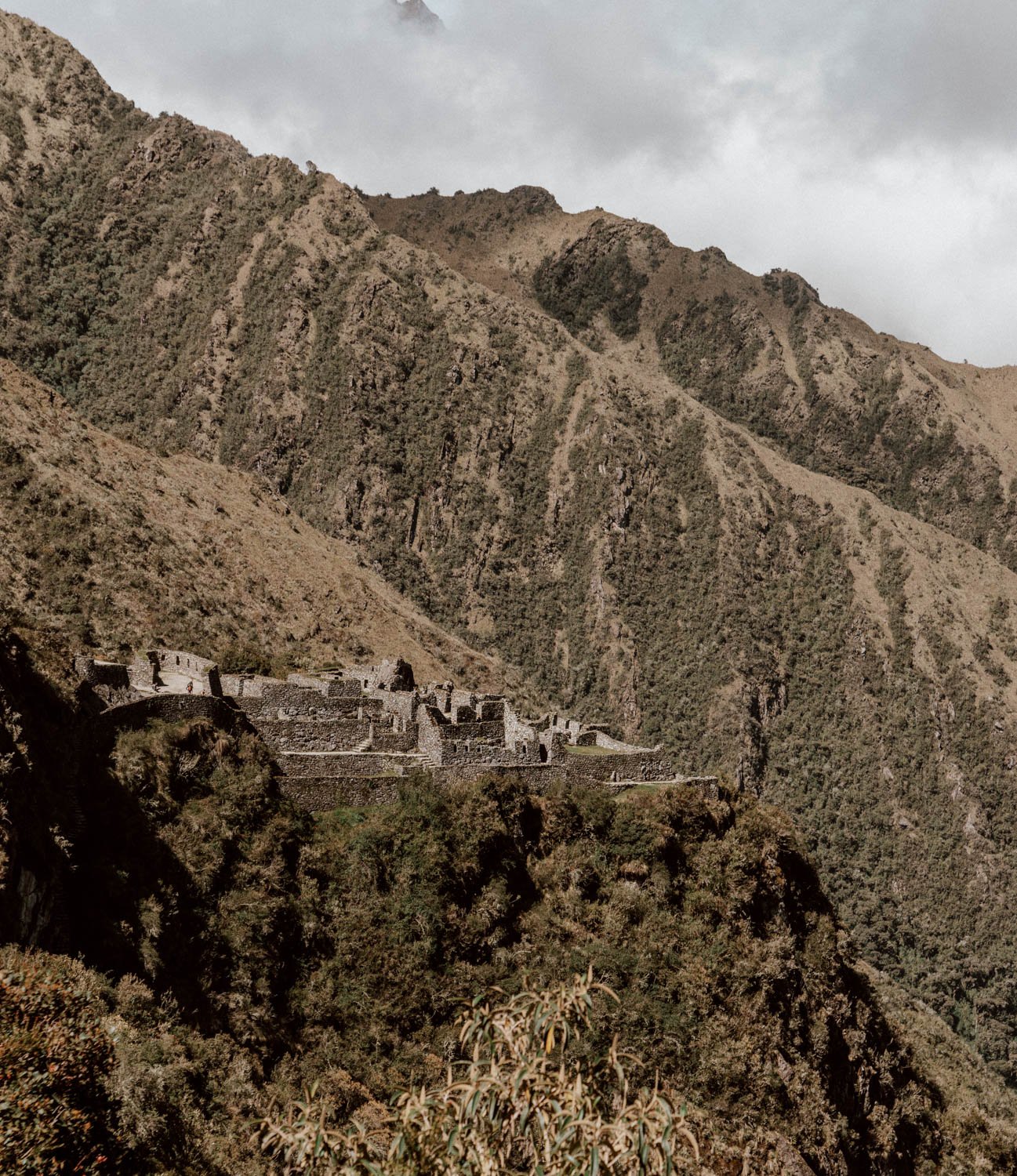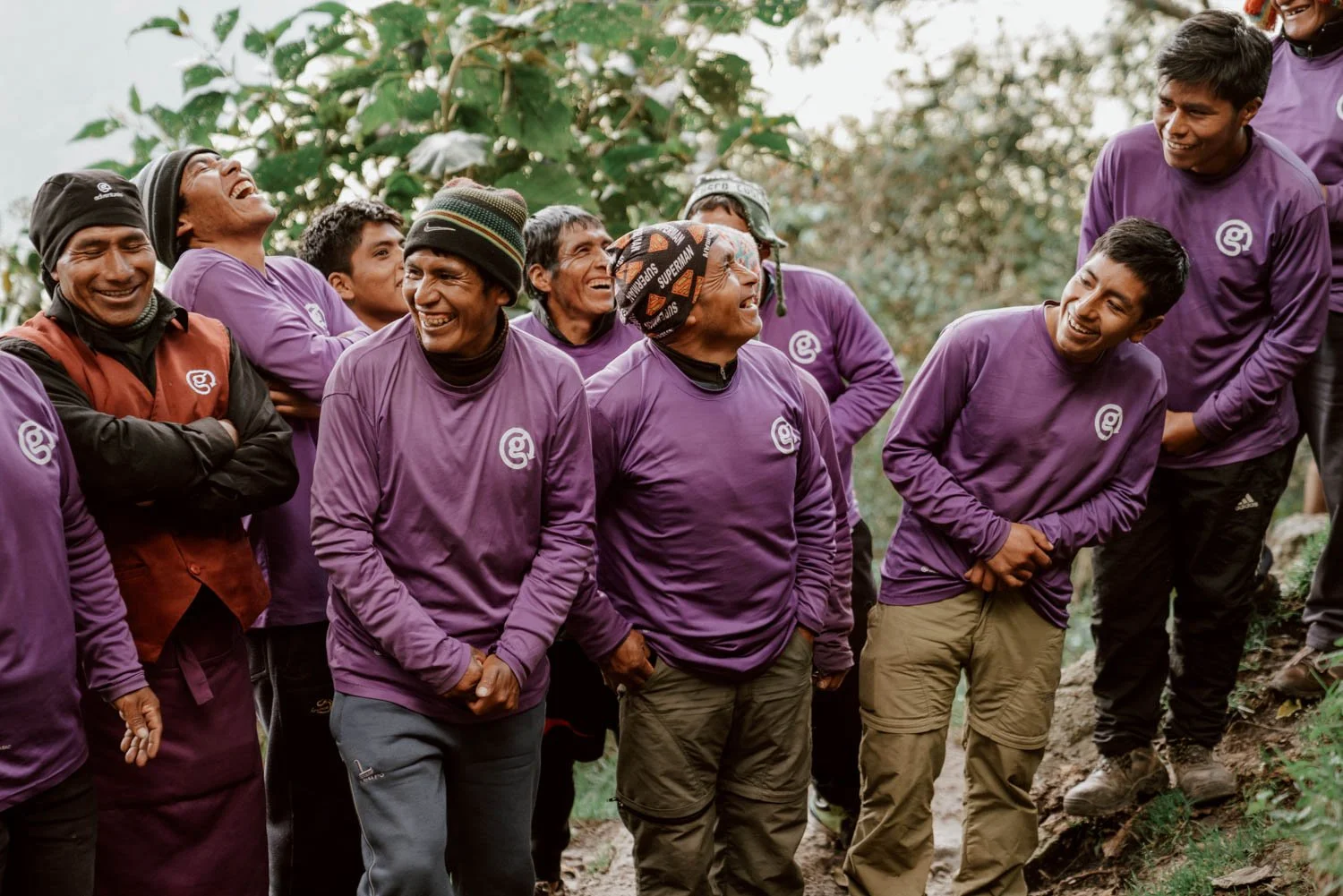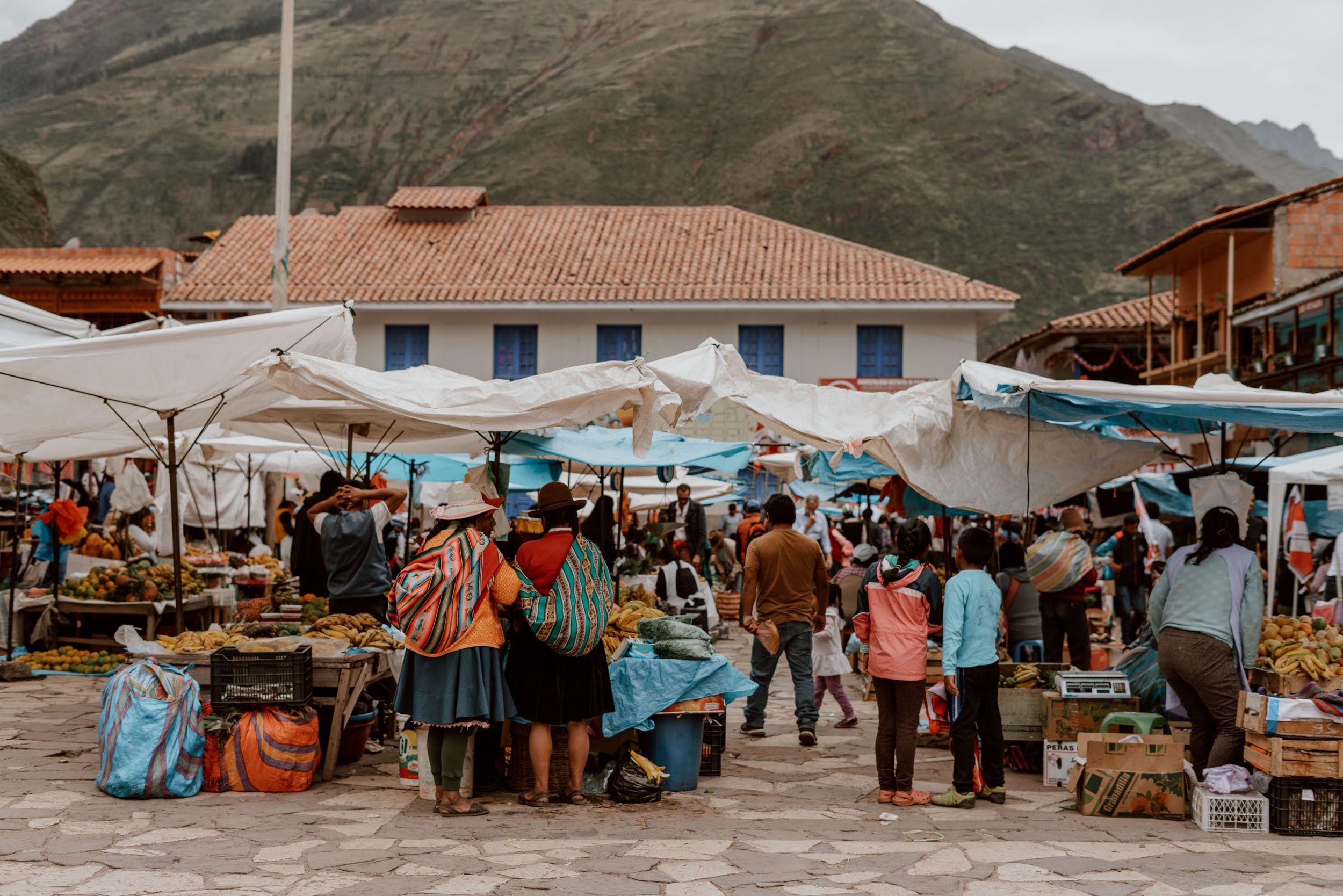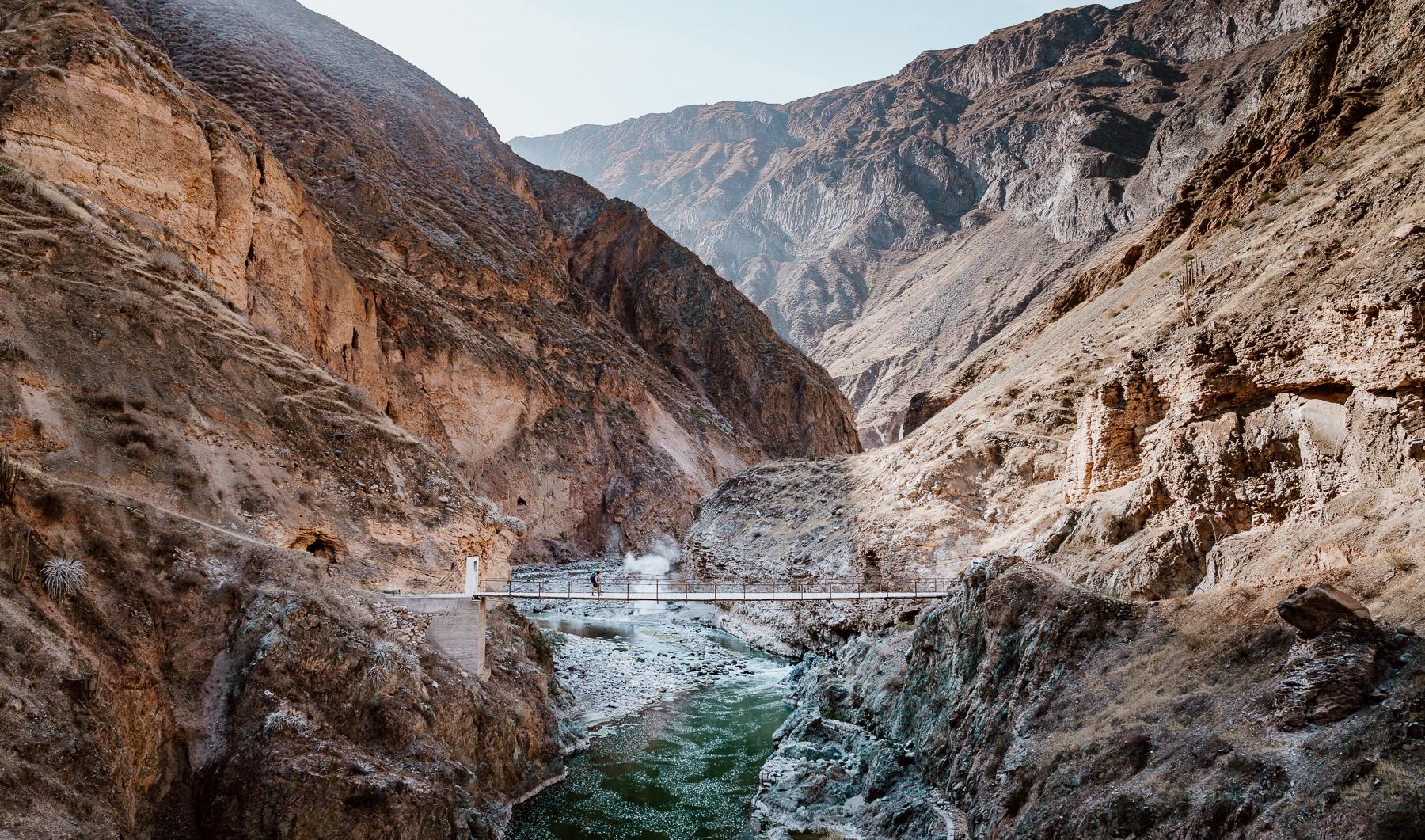Looking for all the essential information to plan and prepare for the Inca Trail hike? You’ll find it in this post.
Updated November 2023
Hiking the Inca Trail is an experience which should inspire excitement, invoke a little bit of fear, stoke jealousy amongst your friends, and stir a sense of wander in your soul.
One of the most popular things to do in South America - and one of the world’s most famous hikes - the Inca Trail is the sort of singular adventures for which we all travel. The hike itself, which brings you along ancient narrow paths deep into the Peruvian countryside and high into the Andean mountains, is gorgeous; perfect Incan ruins, cloud forest, and majestic valley views laid out like breadcrumbs along the way to perhaps the greatest end-point of any multi-day hike on earth, the iconic Machu Picchu.
After our own hike, we wanted to share our hard-earned insights, advice, and tips to help you plan and prepare for your own successful Trail experience - all neatly whittled down into this comprehensive guide.
So, whether you’re heading there in high or low season and want to understand the camping and accommodation situation better, have no idea what to pack or how to get a permit, are worrying about whether you’re fit enough, will get altitude sickness or if it’s too late to book a spot on a tour, then this post will provide you with all the necessary information answers from experienced fellow travellers (and, we hope, quite a bit of excitement and inspiration for the hike itself!).
Ready? Here’s everything you need to know before doing the Inca Trail hike. Let’s go!
What Exactly Is the Inca Trail?
The Inca Trail is a well-established and iconic 4-day, 3-night hike which leads travellers from km.82 (the start point 40 minutes outside the town of Ollantaytambo) all the way to Machu Picchu via its exclusive Sun Gate (also called Inti Punku).
The good news is that it’s a lot shorter than you may expect at only 40 kms (25 miles). The bad news? A significant chunk of that 40 kms is up steep, narrow Andean mountain paths at altitude.
The Incan Empire (which at its largest joined Peru, large parts of modern Ecuador, western and south central Bolivia, northwest Argentina, north and central Chile and a small part of southwest Colombia) created thousands of kilometres of trails to link its important settlements and centres of civilisation, but it is this specific 4 day route which is known as the one and only ‘classic Inca Trail’.
Do note that if you see a tour with fewer days offered, then you are only going to be hiking a small section of the route.
Why Is It So Popular?
The Trail is Peru in a microcosm; lush green cloud forest alive with birds, Andean peaks and steep mountain passes, a landscape dotted with centuries old ruins, accessible only to those that follow this most famous pathway.
However, as truly beautiful as the hike may be, the real reason for its popularity lies at the very end of this four day adventure; passing through the Sun Gate for that first magical sighting of Machu Picchu in the distance. Only Inca Trail hikers can access the Gate at sunrise, and it is this crescendo, at one of the new seven wonders of the world which makes this hike a feature on so many ‘South America bucket lists’.
The Inca Trail hike marked our second time visiting Machu Picchu, and arriving via the Sun Gate with sweaty brows and tired feet rather than taking the morning bus from Aguas Caliente with thousands of others clearly underlined to us that it is the best way to arrive at one of the world’s most iconic attractions.
You will not regret it.
Booking the Inca Trail Hike
What Are Inca Trail Permits And Do You Need a Guide?
Since 2002, access to the Inca Trail has been limited to 500 people per day (roughly split between 200 tourists and 300 accompanying guides and porters), no matter the time of year. This means it is necessary for everyone to obtain permits in advance to do the hike.
Securing a permit is only possible with an approved tour provider, who buy these daily permits in advance. This means that - although many of Peru’s best hikes, like the Colca Canyon, are possible to do independently - you can only do the Inca Trail with an approved tour company and spaces are capped.
What is the best time of year to hike the Inca Trail?
Peru has two seasons - dry and wet - and it is possible to do the Inca Trail in either. Each however, come with their own pros and cons.
Dry Season (May - October)
Pros | The chance of rain, as the name would suggest, is significantly reduced and you can expect hot, dry mornings and afternoons.
Cons | Dry season also coincides with high tourism season in Peru (June - August), so the Inca Trail will be at full capacity each day. This means fuller camp sites and more traffic along the Trail (although the tours do try and stagger this out). Demand for tours also increases in dry season, so you really need to book your own tour further in advance (a rule of thumb is six to seven months, but we have met people who booked a year in advance to assure themselves of a place). Lastly, our guide told us that the nighttime temperatures in dry season drop significantly, so expect cold nights in the tent.
Wet Season (November - April)
We hiked with G Adventures in early December, so we were ready for some rainy days. Thankfully, the weather gods were rooting for us, and we only had one bad rain shower and a single morning of dense mist to contend with - as our guide told us, this won’t always be the case for those hiking the Inca Trail in rainy season.
Pros | A less popular time to hike, so the number of people you’re sharing the Trail with is notably reduced, as are the crowds at Machu Picchu. Tours are slightly cheaper and easier to book with only a few weeks notice (a guy on our tour booked his place only a week before the trip began). Temperatures at night are also less chilly.
Cons | Hiking and camping in the rain for four days is never fun, so you are increasing the chances of that. If there is notable rainfall, then hiking conditions become slippier and more difficult.
Note that the Inca Trail is closed in February for everyone in order to allow it to replenish.
If you’re reading the above and thinking that neither sounds appealing now, then please don’t be too despondent - the Inca Trail can be hiked year-round and we’ve just outlined the worst cons of each season so that you don’t have any nasty surprises!
Do You Need to Book an Inca Trail Tour in Advance?
In short, yes.
If you’re hiking in the dry (high) season, then you should be making a reservation sooner rather than later (i.e. right now). If you’ll be taking an Inca Trail tour in rainy season, a little more spontaneity is possible, unless you have very specific dates in mind where it makes sense to get your booking in sooner rather than later.
Reading this and hoping for a last minute spot? It’s is certainly possible to find one but your options on tour companies and dates will be severely limited.
We did the trek with G Adventures, a global company focused on sustainable small-group adventures (who have also been awarded ‘Best Inca Trail Tour Operator’ by the Regional Direction of Foreign Trade and Tourism of Cusco in Peru) - you can check out the specific tour we did by clicking here. Note that this was a couple of days longer than their standard Inca Trail (some activities and time in the Sacred Valley were bolted on) and for most people, we don’t feel it would be worth the added expense; their four-day option is cheaper.
Alternatively, this highly rated four-day Inca Trail tour has loads of excellent reviews, allows free cancellation), and is even cheaper than the above tour meaning it’s a good option for those on a tighter budget.
If your main consideration however is that you may not be able to hike for the full four days, consider joining this two-day tour. You’ll still be able to access Machu Picchu through the Sun Gate (a really special moment), and you have the added bonus of seeing this incredible Wonder of the World at both sunset and sunrise!
Are There Age Restrictions?
There is no minimum or maximum age limit for hikers on the Inca Trail, but tour companies will operate according to their own guidelines and policies (i.e. G Adventures minimum is 12 years old) . Personally, we wouldn’t recommend anyone under the age of 14 to do the trek due to group dynamics.
If you are a little older in years and need some inspiration, then Alan Goldin is the oldest recorded hiker of the Trail at the age of 84, whilst three of our local porters were 62!
How Much Does The Inca Trail Cost?
All companies operating the Inca Trail must be registered and have a special operators license, which is renewed annually. A large number of these companies are only established to provide specific private tours in high season, with the rest offering year-round expeditions. New operators are added to the list each year so, as you can imagine, quality, experience, and equipment offered will vary quite a lot.
Inca Trail tours cost from £550 per person up to £1,500; if you see a price any cheaper than the bottom-end of this range, then be very sceptical. If you are seeing a higher price than this, then you will either be on a very very luxury tour or likely booking through a tour agent. Note that, aside from the mark-up on price, Inca Trail tours booked via agencies will often simply place you on an available tour with one of several local operators, so you have very little control on the quality of the ultimate provider and group composition.
The G Adventures tour we joined is now £1029 per person (price update 2023), and this included two nights hotel accommodation in Cusco, one night hotel accommodation in Ollantaytambo, private transport, all meals on the Trail, our Inca Trail permit, camping equipment, entrance and a guided tour around Machu Picchu, a support team of 15 or so guides, porters, and chefs, and visits to several Planeterra local community enterprises and projects in the Sacred Valley.
Their shorter tour is around £710 per person, and our recommended cheaper alternative is around £600 - £650 depending upon whether it has a an offer running (which it often does).
Note that it’s often necessary to pay a deposit in advance to secure your Inca Trail permit, so if you go with a new, non-established, or cheaper provider, make sure you have done enough research into them before paying anything. After all, you don’t want the upfront savings to mean inadequate equipment, poor quality food, or a less memorable experience.
Please also be aware that permits are only issued with a tourist’s name and passport number and, once booked, they are non-changeable and non-transferable. If you happen to change your passport between booking and arriving at the entry checkpoint at Km.82 (where they check your passport), then contact your tour company for advice.
Top Tip // As we discussed above, there are cheaper alternatives to the Inca Trail tour we took including a shorter tour by G Adventures, and this highly-rated, four-day tour on Get Your Guide.
Preparing for the Inca Trail
Once you’ve booked a tour and committed to the hike, there are some key milestones to hit before you get anywhere near South America. Preparing for the Inca Trail isn’t just a case of throwing some unworn hiking boots in your backpack and hoping for the best, but rather doing the necessary to ensure you have a successful and unforgettable adventure in the Peruvian mountains for all the right reasons!
How Fit Do You Need To Be?
As mentioned, the Inca Trail isn’t just a walk in the park.
Although it wasn’t by any stretch the most physically challenging hike we’ve done in South America, its ascents and conditions provided enough of a task to make us both feel it. You do not need to be a vastly experienced hiker, but acquiring a good level of physical fitness prior to arriving in Peru will make everything easier and more enjoyable. If you’re reading this and don’t fit the description of someone who does a lot of exercise or could do with losing a few lbs - then don’t be too despondent. Instead, view the Inca Trail as your challenge, your motivation, and your deadline to start walking more, to lose some weight, and to make some positive changes before you fly to Peru (and if you need some inspiration, read this woman’s story).
What Do You Need To Pack For The Inca Trail?
Pack light, pack smart, and pack for two very different temperatures - that’s the key advice for every Inca Trail experience. However, there are a few key things to know about how luggage and kit is transported on the hike before you even think about whether you really need that extra pair of pants.
Firstly, you are going to leave the bulk of your luggage securely in a luggage storage room back at the hotel in Cusco; don’t leave valuables here though as that’s just silly.
Secondly, for our G Adventures tour, we were each supplied with black duffel bags at the hotel. This duffel bag is allowed to hold upto 6kgs, and is going to be where the majority of the kit + equipment you bring for the Inca Trail will be stored (i.e. clothes, sleeping bag, sleeping mat, toiletries). Every Inca Trail tour worth its salt employs and includes an incredible team of support staff who will carry the camping and cooking equipment plus food supplies on the Trail to each campsite (the tour company provides all of this equipment), as well as everyone’s 6kg duffel bag.
These local porters, from fresh-faced 18 year olds to gnarled mountain men, are the unsung heroes of every Inca Trail experience and they will each carry up to 25 kgs on their backs for the group (yep, and you were worried about how hard the Trail would be for you!). Your duffel bag will be collected and weighed each morning to ensure it’s not over the weight limit, and will be waiting for you alongside an erected tent at each campsite.
So, it’s clear that most of the hard work when it comes to carrying things will be done by others and the tour company provides a lot of the key camping equipment. However, you also need to have a small daypack to carry your snacks, camera, water, suncream, and any medication, on the Trail itself - this will be carried by you and only you throughout the trip.
We’ve covered all the essentials you definitely need to buy and pack for either season (plus some ‘nice to haves’) in this Inca Trail Packing List post, whilst more information on the camping + food on the trek is outlined in specific sections below.
When + Where Do You Need To Be In Peru
It is possible to book a longer organised Peru tour which includes the Inca Trail within it, or to simply include it on your own independent Peru + South American adventure. Regardless of which option you go for, all roads will lead to Cusco - the start point for the vast majority of all Inca Trail tours.
Cusco, in the south-east of Peru, thankfully doubles up as one of the country’s most popular destinations due to its history and position as an access point to the Sacred Valley and Machu Picchu, so every Peru itinerary is guaranteed to include at least a few nights here. If you haven’t planned your visit yet, then read our guide to the best things to do in Cusco.
Cusco is exceptionally easy to reach from various parts of Peru, but there are no direct flights to Cusco from the US, Canada or Europe. Instead, these are your best options:
Flights | Fly into Jorge Chavez International Airport in Lima, Peru’s capital city, and connect onto one of the frequent flights from Lima - Cusco run by several airlines. These are consistently cheap (starting from £45 / $60 / €50 per person), reliable, and only take 90 minutes.
If you’re already in Peru or elsewhere in South America, then taking a flight from Lima - Cusco is the quickest and most sensible option.
Bus | If you’re travelling from Arequipa, then an overnight bus to Cusco is your best option. Overnight buses in Peru range from basic to an incredibly high standard - we recommend you take a look at the options and book online via RedBus.
There is a bus which runs from Lima to Cusco, but it takes 24 hours and these days isn’t worth taking as flights are so ubiquitous and affordable (trust us, we did this bus ride back in 2015!)
Train | There is a train which runs from Cusco - Ollantaytambo - Aguas Calientes (the Machu Picchu town), but this is really a tourist service and not relevant for reaching Cusco.
Our G Adventures tour required all participants to be in Cusco for the first night of the 7 day trip, and it’s in the city where you will receive your briefing, rent any additional equipment and meet your tour mates. Given our own independent travel plans, we had actually spent the previous week in Cusco and the surrounding region - for everyone planning on the Inca Trail, we’d recommend arriving into Cusco at least two days before your tour starts so that you can acclimatise to the altitude (it’s at 3,339 metres above sea level) and enjoy what the city has to offer without aching limbs. You can read more about altitude sickness in the ‘Health + Safety’ section towards the bottom of this post.
Once in Cusco, all your transport to the Trail and the return trip to Cusco from Machu Picchu will be arranged by your tour company and included in the overall tour price. This will include a private minibus to Ollantaytambo and km.82 (the Inca Trail start point) and either a train or minibus back to Cusco.
Do You Need Special Inca Trail Insurance?
We would never travel without taking out insurance (if you’re not convinced, read this post), and having the necessary insurance arrangements in place in advance is a requirement for every Inca Trail tour; you are responsible for buying and purchasing this.
It’s worth noting that not all standard off-the-shelf travel insurance policies will cover you for activities at altitude (including the Inca Trail), so you need to ensure that this is covered when buying your single or multi-trip policy. True Traveller and World Nomads are two respected travel insurers which we have used on South America trips who cover high altitude treks (just make double sure that you’ve selected the right option).
If you’re confused about buying travel insurance, read this post and this post.
Hiking the Inca Trail
Inca Trail Map + Route
We’ve outlined our own route on the Inca Trail below and, in broad terms, this is the sort of the itinerary you can expect (note that this relates solely to the days spent on the hike, not the days of travelling to/from Cusco and Ollantaytambo):
Day One: Travel from Ollantaytambo to km.82 in the morning and hike to campsite
Distance | Approx. 6.8 miles/ 11 km
Elevation Gain | 350 metres
Difficulty | Moderate, with a steep tiring section towards the end.
Day Two: Early rise to hike through cloud forest and up to Dead Woman’s Pass and the descent to campsite
Distance | Approx. 7.5 miles/ 12km
Elevation Gain | 1,115 metres
Difficulty | High, this is the hardest day of walking but after you reach DWP, it’s mostly downhill.
Day Three: Early rise to hike the most photogenic section of the Trail
Distance | Approx. 9.6 miles/ 15.5km
Elevation Gain | Minus 1,000 metres
Difficulty | Moderate to a little difficult as there are several steep sections.
Day Four: Very early rise (3 a.m.) to reach the entry check-point and hike 1-2 hours to the Sun Gate and Machu Picchu.
Distance | Approx. 3.1 miles/ 5 km
Difficulty | You’re almost at the end and Machu Picchu, you should be hopping, skipping, and jumping all the way there!
The well-established route is outlined in the below image below (red line) but do note that your own specific campsites and stops may differ depending on your tour provider.
How Difficult is the Inca Trail Hike?
As the above has hopefully made clear, the Inca Trail is not as difficult or challenging as you may think, but every person’s own hike experience will be very subjective based on your fitness, hiking experience, your group’s approach, attitude, the weather conditions on the route, and a bunch of other factors. Day Two of the hike, which leads you from your campsite all the way upto the Dead Woman’s Pass at 4,200 metres (13,776 ft) is widely regarded as the most difficult day of hiking - once you’re passed that, you’ll be laughing (or crying).
Personally, we had some really difficult moments on Day One and Two on the climbs, but the rest of the hike was at the right level of ‘satisfyingly challenging”.
Our own Inca Trail group were all roughly the same age and fitness, which meant that our pace was consistent and we all arrived to rest-stops and campsites at roughly the same time. Our guide kept on calling us all ‘professional hikers’ and the fastest group he’d had that year as we arrived at camp each night a few hours ahead of expected 5-7 hours in his schedule. This won’t always be the case, and your own group is just as likely to contain people of mixed ages and abilities.
There are three important things to note here:
1: The Inca Trail is not about finishing each day as quickly as possible; we felt that our group could have lingered a little more on sections of the hike and slowed our pace. Savour the route, rather than trying to set a record pace (which you’ll never do by the way - it’s currently 3 hours 23 minutes by a porter. There’s even a marathon!).
2: The best tour companies each come with a main guide and an assistant guide - one will lead at the front of your group whilst another will stay at the back. They are experienced in supporting members of a group who may be struggling or slower than the rest, and ensuring that everyone’s experience is the best possible in the circumstances. If you are struggling, it’s their job to control the situation, help you get to camp, and also to manage the overall group schedule.
3: It’s amazing the friendships that can come out of struggle and perseverance. If you are one of the quicker ones in a group, don’t ruin another person’s experience by castigating them for taking longer - everyone has their own challenges,circumstances, and reasons for being on the Trail, and a friendship and positive experience is more likely to blossom out of supporting someone through their struggle. As our guide Elias told us, the key thing for everyone to make the overall experience on the Inca Trail better is a ‘positive mental attitude’.
Do You Need Hiking Poles?
We had always thought that hiking poles were only for old people and Austrians.
However, after asking our followers on Twitter, we were assured that 1. they are really bloody useful and 2. not just for old people and Austrians.
In short, hiking poles are not essential for the Inca Trail; it is 100% possible to do it without them. However, using them is guaranteed make the hike easier for a number of people and result in fewer aches and pains during and post-Trail.
As we were doing so many hikes in South America, we bought these excellent lightweight travel hiking poles in the UK. However, it’s also possible to buy poles in Cusco or to rent them from your tour provider. Just make sure that if yours have exposed spikes, you buy some rubber stoppers in order to use them for the Trail.
To find out what clothes and footwear are best, read our Inca Trail Packing post.
Machu Picchu and the Inca Trail
Although all hikes are more about the journey than a final destination, the Inca Trail stands out as having a destination to beat all others. After all, reaching Machu Picchu is the reason that many of you will be considering this hike in the first place!
When Will You Arrive at Machu Picchu?
A common misconception about the Inca Trail is that it will allow you to be amongst the first people into Machu Picchu - this simply isn’t true as it’s much easier to get through its gates just after opening if you stay in Aguas Calientes the night before and hike or take the bus up. Instead, you’re treated to an entry at the Sun Gate just after sunrise (expect about 6-7 a.m.) and then a wonderful descent down to an uncrowded Machu Picchu with special views of it all the way (trust us, it’s much better than queueing in the pitch black Aguas from 4 a.m. in the morning to get on the first bus up to then queue at the ticket gate).
The ticket for the $12 shuttle bus (30 minutes) down to Aguas Calientes will be included in your tour price and the ticket provided on the day by your guide.
Does the Inca Trail Tour Include Your Machu Picchu Entrance Ticket?
Yep, the cost of entry is included in the tour price and it’s the responsibility of the tour company to take care of all that and provide you with the ticket on the day you’re entering the site.
For all the essential details on visiting Machu Picchu independently, read this post.
How Much Time Will You Have At Machu Picchu?
This will vary from tour to tour, and also may evolve as Machu Picchu continues to change its own rules and restrictions to abate UNESCO’s concerns, but on our own tour we enjoyed a full morning to explore Machu Picchu from about 7 a.m. until 11.30 a.m. (we could have stayed another hour but by that point we were desperate for a beer and lunch!). This also included a guided tour around the site.
In short, you will have plenty time to explore Machu Picchu and take some great photos before the day-tripper hordes arrive.
Facilities + Accommodation on the Inca Trail
If you’ve never camped before, than that is all about to change! There are no hotels on the Inca Trail and your only available accommodation comes in the form of a tent and a sleeping bag in the middle of nature.
The tents are all two-person, meaning you will either be sharing with a friend/other half, or a randomly assigned member of the same sex. For those that would prefer more privacy, you can also pay extra for your own one-man tent.
The porters carry all the tents along the Trail, but you will be responsible for including your sleeping bag and mat in the 6kg duffel bag allowance.
Do You Need To Set Up Camp Each Day?
We have previously taken a three-week overland trip in Africa with G Adventures, where we were responsible for setting up and taking down our tent each day (not so fun in the rain or after a long day). However, on the Inca Trail we experienced comparative luxury as the porters were responsible for setting up the tents each afternoon before you get near camp, and for taking them down and packing up in the morning.
We told you that these guys were absolute heroes.
What Camping Equipment Do You Need to Bring?
As mentioned, the tour company will provide the tents and porters will carry the majority of the camping equipment. You are however responsible for bringing your own sleeping bag, which can be stored within your 6kg duffel bag allowance. We have these excellent lightweight sleeping bags, but it’s also possible to rent them - just note that the ones available for rental are bulky and weigh around 2 kgs.
A very thin sleeping mat was included, and carried by the porter, but it was also possible to rent a thin air-mattress for S/45 / £10 / $13 / €11 which had to be stored in the duffel bag (and weighed around 1 kg).
If you plan on renting the sleeping bag and air-mattress, then just bear in mind that this will take up over 50% of your 6kgs allowance and also takes up most of the room available inside the duffel bag.
Whatever equipment you bring, you may not always get the best night’s sleep - and it may be quite chilly in the evening - but it’s all part of the experience! Just remember to keep your boots, bags, and hiking poles inside incase it rains overnight or a curious dog starts sniffing around...
If you’re going to invest in a high quality travel sleeping bag, then read this post on the essential things to look for before buying.
What’s The Toilet And Shower Situation?
The worst part of hiking the Inca Trail is not the altitude, nor the steep ascents, but rather the toilet options available along the route.
Each campsite has toilet facilities available, but these are often rudimentary squat toilets and with campsites being so remote and over-subscribed, cleanliness understandably isn’t the highest.
Make sure to bring your own toilet paper and hand-sanitiser, and just hold your nose (and maybe close your eyes too) when you need to go. On the first two days of the Trail, there are also local people who have set up toilets for trekkers (charging S/. 1)…and there’s also the bush. Just remember that the 2 soles you’ll pay to enter the modern squeaky clean toilets at the Machu Picchu site will be money very very well spent.
In terms of showers, we’ve found on our various multi-day group hikes that people can be split into two camps:
Those who will take a cold shower rather than being a little smelly.
Those who will take being a lot smelly over taking a cold shower.
Thankfully, we both fall into the latter camp and we always tell people to embrace getting a little stinky and dirty for a few days. For those who are in the former camp, then you’ll be happy to know that two of the three campsites we stayed at had basic shower facilities - just be warned that the water began its journey as snow not too much higher up the mountain, when we say cold, we mean it!
Is There Internet On The Inca Trail?
Nope, and this is one of the best things about it.
Instead, you and your group will spend evening conversing over plastic cups of hot tea, playing card games, or lazing in nature together. Your last chance to use the internet or have a reliable phone signal will be in Ollantaytambo, and your first opportunity will be outside Machu Picchu or in Aguas Calientes.
Money + Food on the Inca Trail
What Are The Meals Like On The Inca Trail?
The biggest surprise for us both on the Trail was just how incredible the food provided was every single day. With G Adventures, two chefs are included as part of the support staff, and the unanimous opinion of our group was that those two performed absolute miracles.
All food, apart from snacks along the way (although we were also provided with a bag of snacks), is included in the up-front tour price - and you won’t have to lift a finger to prepare it or wash up. Instead, around a table in a make-shift tent dining room, we were treated to three-course lunches and dinners and a decent breakfast. Amazingly, no meal was the same as the last (we had sort of expected a lot of pasta!).
A typical dinner included fresh hot soup, a hearty main course, and then something sweet to round it off - all washed down at the end with cups of tea. On our last night, we even got a buffet! We’re both vegetarian and were catered for incredibly well - with each meal giving us a vegetarian version of the same dish the others were eating (another thing we did not expect at all).
We don’t know if all tours will offer the same level of food as G Adventures did, but even if it’s half as good you’ll be very happy. If you have specific dietary requirements, make sure you enquire with your tour provider to make sure you can be catered for adequately.
You can see full details on what’s included in G Adventures Inca Trail Tour here.
Can You Buy Snacks On The Inca Trail?
You are expected to bring and carry your own snacks, although our tour did provide us each with a snack bag on Day One of the trail (we finished ours on the last day, others finished it by Day Two). It makes sense to buy them in Cusco or Ollantaytambo, although on Days One and Two of the trail you will find women along the Trail with makeshift stalls selling drinks, biscuits, and sweets.
Is There Drinking Water on the Inca Trail?
Tours should provide you with purified, safe-to-drink water at camp each night and morning; this in addition to drinks purchased in advance and along the way (and those endless cups of tea glugged at camp) should be sufficient to keep you well hydrated.
However, reducing the plastic footprint and impact of travellers is something we are very passionate about, so it’s important to note that the best way to be guaranteed plenty safe-to-drink water on the Inca Trail (and on future hikes) is to invest in a Lifestraw bottle, which has an in-built filter to remove 99.9% of harmful bacteria. We have used similar bottles on travels in both Africa and South America and can’t talk highly enough of them (our Water-to-Go allowed us to fill up from taps all over Peru, from two rivers on the Inca Trail, and even an ancient water fountain at Machu Picchu).
If you don’t invest in one of these excellent bottles, both of which we’ve tried and tested, then at least bring a refillable water bottle with you.
You can get a 15% discount on the Water-to-Go if you use this code at the checkout (ADR15), and read this post to find out about more ways about how to use less plastic when you travel.
How Much Money Should You Bring On The Inca Trail?
The vast majority of costs will be covered in the up-front price of your tour, but there are a few costs along the way for which you’ll need to bring cash:
Snacks and drinks from stallholders
Toilet entry fees (usually 1 sol, 2 soles at Machu Picchu)
Tips for porters and guides (more on this below).
Lunch at Aguas Calientes.
It’s sensible to take this money in the form of smaller notes and coins.
As our G Adventures Inca Trail tour was actually over seven days, including time in Cusco and Ollantaytambo, we also required cash to cover a few meals as well as spending money for souvenirs in the Sacred Valley. So, whatever you do, don’t underestimate how much cash you will need - we’d say at least 300 soles per person for the Trail-specific section.
Tipping on the Inca Trail
Whichever tour company you do the Inca Trail with, you will be expected to tip your support staff of porters and guides.
As Brits, we fully appreciate that this can result in a bit of uncertainty and awkwardness for those of us who haven’t been raised in a tipping culture (just pay more in wages, no?), but after your time on the Trail you will be left in no doubt that those porters deserve an extra bit of cash to recognise their sterling work and to support their own endeavours in life.
The process and guideline amounts will vary from tour company to tour company, but with G Adventures our group circulated an envelope amongst us so that everyone could confidentially put in what they were happy with, and then presented that to the porters on our last evening at camp.
Amongst various tour companies’ advice online, the tipping recommendations average out at 100 - 150 soles per hiker to the group of porters and cooks (who will take care of splitting it amongst themselves). For your main and assistant guide, 25 - 50 soles for the former and 10 - 25 soles for the latter is advised per hiker.
Tipping is not mandatory, and you are entitled to put in more, less, or nothing at all.
Health + Safety on the Inca Trail
Being in decent shape, acclimatising, carrying out a few practice hikes at home, keeping yourself hydrated, wearing in your hiking boots, and taking out the correct travel insurance are essential to staying safe and healthy on this hike; if you’ve made it this far down in our Inca Trail Guide and taken our advice on board, then you should have very few issues once you hit the Trail.
Will I Get Altitude Sickness on the Inca Trail?
Many of the most popular places in Peru, such as Cusco and Arequipa, are at high altitude; this means that for anyone planning a trip to Peru understanding altitude sickness (and how to avoid it) is incredibly important. In fact, not approaching altitude correctly is one of the biggest mistakes of travellers in South America.
The best way to minimise the likelihood and / or impact of altitude sickness is factoring in enough time into your Peru itinerary to acclimatise to the conditions. This means that it is incredibly foolish to arrive in Cusco, which is at 3,339m (11,151 feet) above sea-level, and leave the next day to do a strenuous hike or even start the Inca Trail. Your body needs the time to adjust!
A good rule of thumb is to give yourself and your body two easy days at altitude to acclimatise to the change, and to keep yourself well hydrated throughout. In our group of 10, three people were feeling the altitude on the first day of the tour due to lack of acclimitisation, but with more time, water, and a healthy dose of coca tea (the age-old Peruvian cure!) they soon adjusted and had no issues by day one of the hike itself.
For more information on altitude sickness, the symptoms, and how to deal with them in Peru, read this post.
What Do I Do With My Valuables?
This is one area where the tour companies could provide a better solution, although we appreciate our situation as travel photographers and bloggers who carry a lot of technology is a little unique.
Your main luggage will be left in a secure hotel luggage storage room in Cusco, however we do not advise leaving any important or valuable items there - instead, it’s better to take them with you and keep them in your own daypack. If hotels and tour companies offered lockers in Cusco which travellers could secure with their own padlock, then this would have allowed us to leave various cards, cash, and tech with confidence (and insurance coverage) in the city rather than carrying it all in our backpack on the trail (Andrew actually lugged 18 kgs on his back for the entirety of the trail because of this, so views himself as an honorary porter!)
Remember to pack smart and pack light for the Inca Trail - find out exactly what you need to bring and leave behind in our Inca Trail Packing List.
What About Medication?
Obviously, medical attention and facilities along the Inca Trail are pretty much non-existent so you need to bring any of your own required medication with you and keep it on your own person or in the daypack. If you do have any pre-existing medical requirements, inform your tour company when booking and also remind the CEO before setting out.
Don’t Skimp on Travel Insurance
We’ve mentioned this earlier, but with the understanding that this is such an important purchase before you step foot in Peru, we thought it only correct to mention it again here.
Despite your best efforts (as well as the efforts of your CEO, porters etc), things can and do go wrong; if you get sick whilst hiking and are unable to make your own way back, without travel insurance, your evacuation will get expensive pretty quickly. Now, the important thing to note here is that your bog-standard, one-size-fits-all travel insurance will almost certainly not cover you getting unwell at significant altitude - you’ll need to buy an add-on which specially covers hiking at high altitude. We have used True Traveller for years, and they offer an add-on for a reasonable price that covers most altitude hikes found in Peru.
If you have any doubts about whether you are covered for hiking the Inca Trail, speak with your insurance company. Lastly, make sure you have the policy number, insurance provider, and emergency contact number on your person whilst hiking.
If you’ve made it to the end of the post, then congratulations! We also truly hope that most of your questions about the Inca Trail hike have now been answered and you are in the best position possible for your upcoming Peruvian adventure. If there are any updates or questions, feel free to let us know in the comments below!
If you are yet to book a tour, then we can highly recommend the 7-day G Adventures Inca Trail tour which we joined - it exceeded our expectations.
If your budget is a little higher, or you’d prefer a longer organised tour in Peru, they also offer a 14-day National Geographic ‘Iconic Peru’ tour which includes the Inca Trail, the Amazon, Lake Titicaca, and return flights from Lima - Cusco.
If you’re all booked and ready to start preparing, then make sure to read our Inca Trail Packing List before you buy anything.
Where to Next
13 Wonderful Things to Do in Cusco
18 Things to Know Before You Visit Cusco
7 Excellent Day Trips From Cusco
A Complete Guide to Exploring Cusco’s Ruins (Without a Tour)
What You Need to Know To Visit Machu Picchu in 2021
The Inca Trail Hike | A Complete Guide
11 Things to Know Before You Visit Rainbow Mountain
Everything You Need to Know About Cusco’s Boleto Turistico
A Day Trip to Pisac | The Ruins & Market
A Complete Guide to Visiting Ollantaytambo



